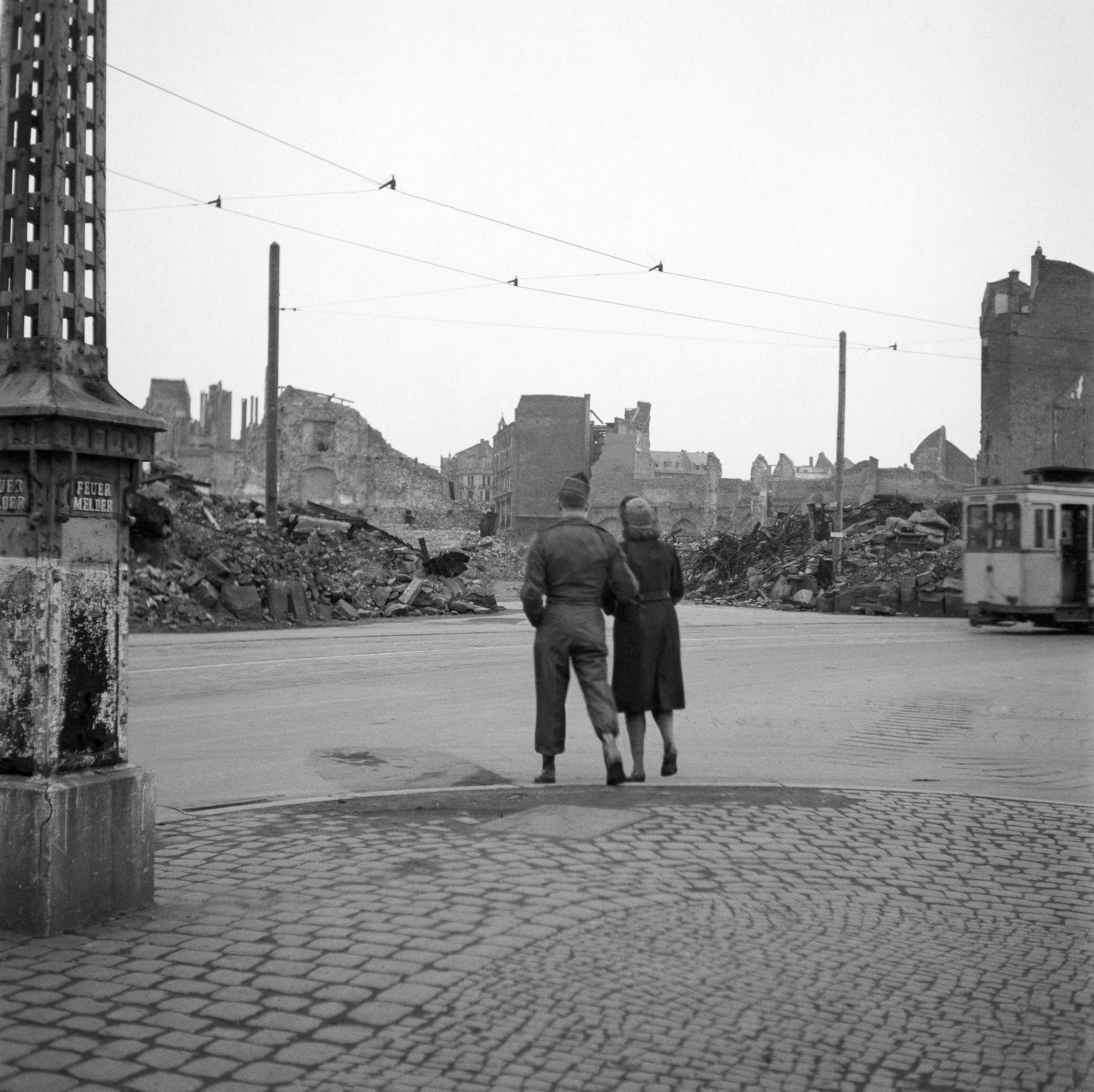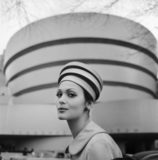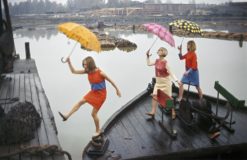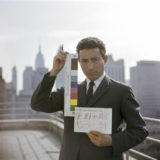Ein Fotografenleben vom Krieg zur Kultur
01.10. – 04.12.2022 / Eröffnung: 30.09.2022, 19 Uhr
kuratiert von Barbara Hofmann-Johnson, Leiterin Museum für Photographie Braunschweig
(see english version below)

Tony Vaccaro, ‚Entering Germany, Frankfurt Germany‘, 1947
© Tony Vaccaro Studio, Courtesy of Monroe Gallery of Photography and the Tony Vaccaro Studio
Am 20.12.2022 wird der in Long Island / New York lebende amerikanische Fotograf Tony Vaccaro,
100 Jahre alt. Ein Anlass sein vielschichtiges fotografisches Werk, das historisch und gesellschaftlich
betrachtet unterschiedliche Themen und Genres im Bereich der Schwarzweiß- und Farbfotografie
einschließt, im Museum für Photographie Braunschweig zu präsentieren.
Während des Zweiten Weltkriegs kam Tony Vaccaro Ende 1944 mit der 83. Infanteriedivision der
US amerikanischen Armee an die Normandie-Front nach Europa und dokumentierte in den letzten
Kriegsmonaten seine Kriegserlebnisse und -erfahrungen mit seiner Kamera, einer Argus C-3,
in Belgien, Frankreich und in Deutschland. Die Schrecken des Krieges erscheinen dabei oft in symbolische
Bilder gefasst, womit er innerhalb des Genres der Kriegsfotografie einen eigenen Beitrag
geleistet hat. Im Anschluss an den 2. Weltkrieg blieb Tony Vaccaro bis 1949 in Frankfurt und dokumentierte
das Nachkriegsleben des Wiederaufbaus in Deutschland und Europa für das Magazin
‚Stars and Stripes‘, eine amerikanische Militärzeitung und deren Wochenendbeilage ‚Weekend‘. Im
Juli 1949 kehrte er auf einem Schiff nach Amerika zurück und wurde in den folgenden Jahren in
New York zu einem wichtigen Bildchronisten einer sich wandelnden Gesellschaft.
Sowohl die Kunst- und Kulturszene als auch das politische öffentliche Leben wurden seit 1950 zu
Themen des Fotografen. Portraits, von Künstlerinnen und Künstlern, Architekten, Schauspielerinnen
und Schauspielern oder Designer:innen gehören zu wichtigen Themenfeldern der Arbeit von
Tony Vaccaro, ebenso wie Portraits von Politikern wie John F. Kennedy oder dem bekannten Boxer
Muhammad Ali. Das Bild von Queen Elisabeth II. und Prinz Philip, Duke of Edingburgh hoch zu Ross
während der traditionsreichen Parade ‚Trooping the Colours‘ im Juni 1971 erinnert an die Regentin
und ihre Liebe zum Reiten ebenso wie ihre Achtung vor der Tradition. Tony Vaccaros Fotografien
und Reportagen erschienen u. a. in Magazinen wie ‚Look‘, ‚LIFE‘, ‚Newsweek‘ oder ‚Flair‘.
Auch Modefotografie rückte bisweilen in den Fokus von Vaccaro, wobei die Zusammenarbeit mit
dem finnischen Fotomodel Anja Kyllikki Lehto (1939-2013), die er 1963 in New York traf und die
seine Ehefrau wurde, zu besonderen Aufnahmen führte. Szenisch und einfallsreich erscheinen
sie mehr als Kunstaktionen denn als Modeinszenierungen. Dies gilt in besonderem Maße auch
für die Bildstrecke, die über das individuelle Modehaus Marimekko 1965 bei Helsinki in Finnland
entstand. Sie erschien im Magazin ‚LIFE’ am 24.6.1966. Tony und Anja Vaccaro bekamen zwei Söhne
und lebten einige Jahre in Rom, bevor sie sich 1979 trennten. Rom war bereits seit den 1950er
Jahren für Tony Vaccaro die Stadt, in der er seine Sommer verbrachte.
Die Ausstellung im Museum für Photographie Braunschweig entsteht in Zusammenarbeit und
mit Unterstützung durch das Tony Vaccaro Studio, New York City, USA und der Monroe Gallery
of Photography Collection, Santa Fe, NM, USA.
- Tony Vaccaro, 'The Guggenheim Hat, New York 1960'
© Tony Vaccaro Studio, Courtesy of Monroe Gallery of Photography and the Tony Vaccaro Studio
- Tony Vaccaro, 'Fun in Finland, Marimekko, Helsinki, Finland 1965'
© Tony Vaccaro Studio, Courtesy of Monroe Gallery of Photography and the Tony Vaccaro Studio
- Tony Vaccaro, 'Tony Vaccaro Holding a Test Strip, New York 1960'
© Tony Vaccaro Studio, Courtesy of Monroe Gallery of Photography and the Tony Vaccaro Studio
TONY VACCARO 100!
A Life of a Photographer from War to Culture
On December 20, 2022, the American photographer Tony Vaccaro, who lives in Long Island / New
York, will be 100 years old. An occasion to present his multi-layered photographic work, which is
historically and socially significant and includes various themes and genres in the field of blackand-
white and color photography, with a selection of his photographs, many of which have also
won awards, at the Museum für Photographie Braunschweig.
During World War II, Tony Vaccaro arrived in Europe at the end of 1944 with the 83rd Infantry Division
of the U.S. American Army on the Normandy Front. In the final months of the war, he documented his
wartime experiences and adventures with his camera, an Argus C-3, in Belgium, France and Germany.
The horrors of war often appear in symbolic images, with which he has made his own contribution
within the genre of war photography. Following World War II, Tony Vaccaro remained in Frankfurt
until 1949, documenting the post-war life of reconstruction in Germany and Europe for the magazine
‚Stars and Stripes‘, an American military newspaper and its weekend supplement ,Weekend‘.
In July 1949 he returned to America on a ship and in the following years in New York became an
important visual chronicler of a changing society. Both the art and cultural scene and political
public life became the photographer‘s subjects from 1950 onward. Portraits of artists, architects,
actors and actresses and designers are among the most important subjects of Tony Vaccaro‘s
work, as are portraits of politicians such as John F. Kennedy and the famous boxer Muhammad
Ali. The picture of Queen Elizabeth II and Prince Philip, Duke of Edinburgh on horseback during the
traditional ,Trooping the Colours‘ parade in June 1971 is a reminder of the regent and her love of
riding as well as her respect for tradition. Tony Vaccaro‘s photographs and reportages have appeared
in magazines such as ‚Look‘, ‚LIFE‘, ‚Newsweek‘ and ‚Flair‘.
Fashion photography also came into the photographer‘s focus at times, with collaborations with
the Finnish model Anja Kyllikki Lehto (1939-2013), whom he met in New York in 1963 and who
became his wife, resulting in special photographs. Scenic and imaginative, they appear more as
art actions than fashion stagings. This is particularly true of the series of images made about the
individual fashion house ‚Marimekko‘ in Finland near Helsinki in 1965. It appeared in the magazine
‚LIFE’ on June 24, 1966. Tony and Anja Vaccaro had two sons and lived in Rome for several years
before separating in 1979. Rome had been the city where Tony Vaccaro spent his summers since
the 1950s.
The exhibition at the Museum für Photographie Braunschweig is created in cooperation and with
the support of Tony Vaccaro Studio, New York City, USA and the Monroe Gallery of Photography
Collection, Santa Fe, NM, USA.
Rahmenprogramm / accompanying program
Eröffnung / Opening
Freitag 30.09.2022, 19 Uhr / Friday 30.09.2022, 7 pm
Begrüßung / welcome
Regine von Monkiewitsch, 1. Vorsitzende Museum für Photographie Braunschweig /
First Chairwoman Museum für Photographie Braunschweig
Dr. Tabea Golgath, Stiftung Niedersachsen / Foundation of Lower Saxony
Barbara Hofmann-Johnson, Leiterin Museum für Photographie Braunschweig und Kuratorin der Ausstellung /
Director Museum für Photographie Braunschweig and curator of the exhibition
Künstlergespräch via Zoom / Artist Talk via Zoom
Samstag 01.10.2022 / Saturday 01.10.2022
mit Tony Vaccaro und der Kuratorin Barbara Hofmann-Johnson / with Tony Vaccaro and curator Barbara Hofmann-Johnson
Informationen zum Zugang nach erfolgter Anmeldung / Access information after registration at info@photomuseum.de
Jour Fixe: Tony Vaccaro-Künstler:innenportraits und Modeaufnahmen
Dienstag, 25.10.2022, 18:30 Uhr
mit Finn Schütt, Wissenschaftlicher Mitarbeiter, Museum für Photographie Braunschweig
Eintritt frei für Mitglieder, Gäste 5 €
Happy Thursday
Donnerstag, 03.11.2022, 13-20 Ur / Thursday, 03.11.2022, 1-8 pm
Kuratorinnenführung um 18 Uhr
mit Barbara Hofmann-Johnson / curator tour with Barbara Hofmann-Johnson at 6 pm
Eintritt frei / free Entry
Jour Fixe: ‚Entering Germany‘ – Tony Vaccaro und die Kriegsberichterstattung als fotografisches Genre
Dienstag, 22.11.2022, 18:30 Uhr / Tuesday, 22.11.2022, 6:30 pm
mit Franziska Habelt, Wissenschaftliche Mitarbeiterin, Museum für Photographie Braunschweig
Eintritt frei für Mitlgieder, Gäste: 5 € / Entry free for member, guests 5 €
Happy Thursday
Donnerstag, 01.12.2022, 13-20 Uhr / Thursday, 01.12.2022, 1-8 pm
Öffentliche Führung um 18 Uhr / guided tour at 6 pm
Eintritt frei / free Entry
Finissage und Adventspunsch / Finissage and Advent punch
Sonntag, 04.12.2022, 16 Uhr / Sunday, 04.12.2022, 4 pm
Ausstellungsrundgang mit der Kuratorin Barbara Hofmann-Johnson / guided tour with curator Barbara Hofmann-Johnson




